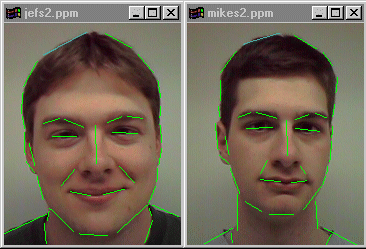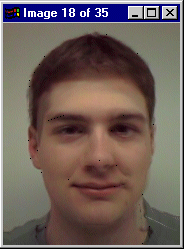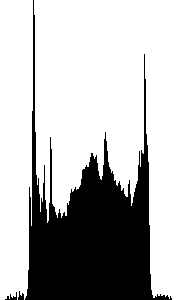Introduction
One problem with the feature-based morphing technique of Beier and Neely
is that all features had to be specified by the animator. However, in
highly correlated images, such as faces, finding features should be able
to be found automatically. The goal of my project was to find these
corresponding features.
Technique
I begin by making several assumptions, which may be summarized as "the scene is very well behaved". I assume:
- the faces are in the middle third of the images
- the faces are aligned
- the faces have similar features (eyes are open, mouth is closed, neither
subject is wearing glasses, etc.)
- the faces are facing forward
- the faces are similarly sized
- the background is a fairly constant color
- the scene is well-lit
My goal was to implement my technique for these assumptions, and if that
worked, to slowly pare the assumptions in the order given.
My technique begins by first converting the image to grayscale, and then using
the Sobel operator for edge detection. Once I have a set of edges, I calculate
the edge magnitudes and generate row-wise and column-wise histograms of the
magnitude (see below).
I then use the histograms to find the center of my face. I find the location
of highest symmetry by finding the least SSD.
From there, I then planned to examine the column-wise histogram (see below) to
find the outer edges of the heads: the sides of the head will be located along
the maxs on either side of the line of symmetry. The top of the head would be
found in a similar manner using the row-wise histogram. Then, edge following
would be used to draw the lines for the outside of the head. Once these edges
had been found, I would use higher-level knowledge of the shape of a face to
narrow my search space for the other features. Again, the edges would be used
to find the best features.
Results
I first implemented the morphing techniques, trying to provide a decent user
interface. Below is a set of faces with lines, an intermediate image with
lines, and the final morph. There are 36 control lines and 33 intermediate
images. The morph took approximately 9 minutes to generate on a 300 Mhz
Pentium II, and significantly longer to find control lines.
I did not quite get as far as I had hoped to for this project. Below is my
the beginnings of my technique, showing the edge magnitudes, the histograms,
and the center line I found.
FUTURE WORK
I think that my results thus far show that my project might have a chance at
working had I fully implemented it. It may be possible to use Seitz and
Dyer's view morphing techniques to align a face. I could then find features
as I would have before, and inverse project the lines so that they match the
original features. I could use the same technique to interpolate the lines.
Bibliography
Beier T. and Neely, S. "Feature-based Image Metamorphosis".
Proc. SIGGRAPH 1992, 35 - 42
Seitz, S. M. and Dyer, C. R. "View Morphing". Proc. SIGGRAPH
1996, 21 - 30















